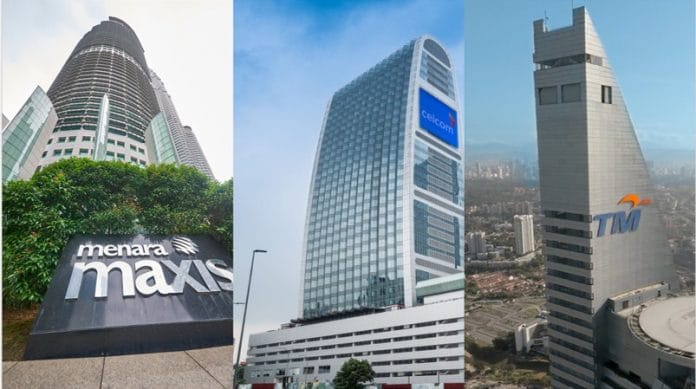The Malaysian economy experienced a robust resurgence in the year 2022, marked by a remarkable GDP growth rate that reached a 22-year peak at 8.7%. This positive trend is expected to persist, with a projected CAGR of 4%-5% forecasted for the period from 2023 to 2027.
Twimbit in its State of Telco’s in Malaysia report 2023, noted that the local telecommunications market is characterised by its high competitiveness, with the top three telcos—Telekom Malaysia, Maxis, and CelcomDiGi—accounting for a substantial share (~90%) of the total revenue in 2022. The competitive landscape experienced a significant shift in 2022 due to the merger of Digi and Celcom, resulting in the combined entity (CelcomDiGi) securing the second position with a revenue market share of ~32%. Malaysian telcos are strategically concentrating their efforts on driving revenue through avenues such as fibre broadband deployment, 5G service offerings, digital initiatives, and targeted approaches towards the enterprise sector.
The Government’s initiative to offer affordable telecom services will drive the overall market revenue. Malaysia’s overall telecom market revenue is estimated to grow at a CAGR of 3.7% between 2023-27, to reach ~USD 10.6 billion (MYR 46.6
billion) by 2027.
The telco market is poised for significant expansion, primarily propelled by robust growth in the enterprise and fixed broadband segments. Telcos are enhancing their digital capacities in areas like AI, Cloud, and Cybersecurity to address the increasing demands of business digitalization. Projections indicate that the enterprise sector is anticipated to experience a CAGR of 6.6% from 2023 to 2027, while fixed broadband subscriptions are expected to surge by 8.2%, resulting in an overall revenue growth of 3.7% over the same period from 2023 to 2027.
However, the overall mobile segment revenue is estimated to witness a modest growth of ~2.7% over 2023-27 to reach ~USD 5.1 billion (MYR 22.5 billion) by 2027, owing to stagnancy in ARPU level existing due to high competition level.
The Blended ARPU for telcos has experienced a decline, and this trend is likely to persist due to the launch of the “Unity Package” by the Malaysian Government, aimed at providing affordable internet access. While this might lead to a mild
dilution of ARPU in the midterm, stability in ARPU is anticipated over the longer term.
The report points to the total mobile subscribers in Malaysia to grow to 53.4 million in 2027 with a CAGR~1.6% (2023-2027), while fixed broadband subscribers will grow with a CAGR of ~8.2% (2023-2027) to reach 6.4 million by 2027.
Additionally, Telco’s in Malaysia are promoting their 5G services to increase the adoption. Additionally, the Malaysian Government intends to divest its stake in Digital National Berhad once certain network rollout targets are achieved and plans to implement a second 5G wholesale network rollout. As a result, 5G subscription penetration to the overall mobile broadband subscriptions is predicted to surge from 0.8% in 2021 to ~22.6% by 2027 to reach 12 million subscribers in 2027.
Aligned with the Government’s JENDELA initiatives, telcos are consistently expanding their network infrastructure to deliver improved broadband services, particularly in underserved regions. Telekom Malaysia has consistently recorded the highest Capital Expenditure (Capex) since 2019, followed by Maxis and Celcom.
The Malaysian telecommunications market is currently undergoing a phase of digital inclusion, which is likely to intensify driven by increased adoptions of high- speed mobile internet plans synchronous with increase in 5G adoption, enhancing customer experiences through digital technology utilisation, and boosting revenue through convergent offerings.
The Malaysian Government, through the establishment of the Malaysia Digital Economy Blueprint and the Digital Investment Office in 2021, has set its sights on attracting a substantial USD 16.1 billion in digital investments by 2025. This targeted
investment influx is projected to contribute ~25.5% to the GDP, marking an increase from the observed 23.5% contribution in 2021. Furthermore, as telcos concentrate on advancing the commercial rollout of 5G services and harnessing fibre infrastructure for integrated offerings, a robust demand for their services is anticipated.
However, the period 2023-24 may present challenges for telcos, driven by heightened competition, particularly with the emergence of CelcomDiGi. Additionally, regulatory changes are on the horizon, including the potential divestment of the government’s stake in DNB, once the latter attains its network rollout objective. Furthermore, the prospect of allowing a second 5G network rollout once the coverage reaches 80% of the population, coupled with considerations like introduction of 5G wholesale fees and the imposition of a Mandatory Standard on Access Pricing (MSAP) for fibre services, may result in higher operational costs and lower profitability for telcos.
Notwithstanding these challenges, the provision of affordable and accessible connectivity offerings by telcos, coupled with government-supported regulations, will persistently work to narrow the digital divide between rural and urban areas. Concurrently, increased user participation in the digital marketplace is poised to drive digital inclusion, thereby fostering an upward trajectory for the Malaysian digital economy.









